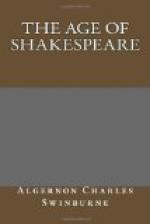A further and deeper debt of thanks is due to Mr. Bullen for the recovery of “The Captives; or, The Lost Recovered,” after the lapse of nearly three centuries. The singularly prophetic sub-title of this classic and romantic tragicomedy has been justified at so late a date by the beneficence of chance, in favorable conjunction with the happy devotion and fortunate research of a thorough and a thoroughly able student, as to awaken in all fellow-lovers of dramatic poetry a sense of hopeful wonder with regard to the almost illimitable possibilities of yet further and yet greater treasure to be discovered and recovered from the keeping of “dust and damned oblivion.” Meantime we may be heartily thankful for the recovery of an excellent piece of work, written throughout with the easy mastery of serious or humorous verse, the graceful pliancy of style and the skilful simplicity of composition, which might have been expected from a mature work of Heywood’s, though the execution of it would now and then have suggested an earlier date. The clown, it may be noticed, is the same who always reappears to do the necessary comicalities in Heywood’s plays; if hardly “a fellow of infinite jest,” yet an amusing one in his homely way; though one would have thought that on the homeliest London stage of 1624 the taste for antiphonal improvisation of doggrel must have passed into the limbo of obsolete simplicities. The main plot is very well managed, as with Plautus once more for a model might properly have been expected; the rather ferociously farcical underplot must surely have been borrowed from some fabliau. The story has been done into doggrel by George Colman the younger: but that cleanly and pure minded censor of the press would hardly have licensed for the stage a play which would have required, if the stage-carpenter had been then in existence, the production of a scene which would have anticipated what Gautier so plausibly plumed himself upon as a novelty in stage effect—imagined for the closing scene of his imaginary tragedy of “Heliogabalus.”




